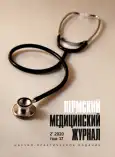Application of biomechanical research methods in evaluating results of surgical treatment of children with Legg – Calve – Perthes disease
- Authors: Baindurashvili A.G.1, Kostomarova E.A.1, Nikityuk I.E.1, Kononova E.L.1, Barsukov D.B.1, Baskov V.E.1, Pozdnikin I.Y.1, Bortulev P.I.1
-
Affiliations:
- Turner National Medical Research Center for Children’s Orthopedics and Trauma Surgery
- Issue: Vol 37, No 2 (2020)
- Pages: 54-64
- Section: Original studies
- URL: https://journals.rcsi.science/PMJ/article/view/34264
- DOI: https://doi.org/10.17816/pmj37254-64
- ID: 34264
Cite item
Full Text
Abstract
Objective. To study the functional state of the musculoskeletal system in patients with Legg – Calve – Perthes disease after surgical treatment.
Material and methods. The study of 31 patients at the age of 8 to 13 years with unilateral Legg – Calve – Perthes disease (LCPD) was performed in the period from 2 to 5 years after surgical treatment. In the control group (15 children), correcting (varus) osteotomy (VO) was fulfilled, in the main group (16 children) – triple pelvic osteotomy (TPO), and the group of healthy children (18 persons) was examined as well. Walking biomechanics was studied using of the STEDIS complex (Neurosoft LLC, Ivanovo, Russia). The vertical balance of the body was evaluated on a stabilometric platform MBN "Biomechanics" (LLC NMF MBN, Moscow).
Results. After surgical treatment, the indicators of vertical balance and biometry of the step phases in both groups of children with LCPD did not reach the same level as in healthy individuals at the indicated follow-up dates. The least significant indicators of step phase asymmetry were found in patients after TPO compared with patients after VO. In patients after VO, the destabilization of the center of pressure significantly exceeded that in patients after TPO.
Conclusions. Biomechanical studies allow us to compare the functional results of various techniques of surgical treatment of children with unilateral LCPD. After TPO operation, patients have a more complete restoration of the supportability of the affected lower limb compared to VO operation.
Full Text
##article.viewOnOriginalSite##About the authors
A. G. Baindurashvili
Turner National Medical Research Center for Children’s Orthopedics and Trauma Surgery
Email: ekaterina.kostomarova@mail.ru
MD, PhD, Professor, Academician of RAS, Honoured Doctor of RF, Director
Russian Federation, Saint PetersburgE. A. Kostomarova
Turner National Medical Research Center for Children’s Orthopedics and Trauma Surgery
Author for correspondence.
Email: ekaterina.kostomarova@mail.ru
postgraduate student, traumatologist-orthopedist of Department of Hip Joint Pathology
Russian Federation, Saint-PetersburgI. E. Nikityuk
Turner National Medical Research Center for Children’s Orthopedics and Trauma Surgery
Email: ekaterina.kostomarova@mail.ru
Candidate of Medical Sciences, leading researcher of Physiological and Biomechanical Research Laboratory
Russian Federation, Saint-PetersburgE. L. Kononova
Turner National Medical Research Center for Children’s Orthopedics and Trauma Surgery
Email: ekaterina.kostomarova@mail.ru
Candidate of Medical Sciences, senior researcher of Physiological and Biomechanical Research Laboratory
Russian Federation, Saint-PetersburgD. B. Barsukov
Turner National Medical Research Center for Children’s Orthopedics and Trauma Surgery
Email: ekaterina.kostomarova@mail.ru
Candidate of Medical Sciences, senior researcher of Department of Hip Joint Pathology
Russian Federation, Saint-PetersburgV. E. Baskov
Turner National Medical Research Center for Children’s Orthopedics and Trauma Surgery
Email: ekaterina.kostomarova@mail.ru
Candidate of Medical Sciences, Head of Department of Hip Joint Pathology
Russian Federation, Saint-PetersburgI. Yu. Pozdnikin
Turner National Medical Research Center for Children’s Orthopedics and Trauma Surgery
Email: ekaterina.kostomarova@mail.ru
Candidate of Medical Sciences, researcher of Department of Hip Joint Pathology
Russian Federation, Saint-PetersburgP. I. Bortulev
Turner National Medical Research Center for Children’s Orthopedics and Trauma Surgery
Email: ekaterina.kostomarova@mail.ru
researcher of Department of Hip Joint Pathology
Russian Federation, Saint-PetersburgReferences
- Leroux J, Abu Amara S, Lechevallier J. Legg-Calvé-Perthes disease. Orthop Traumatol Surg Res 2018; 104 (1S): 107–112.
- Скворцов Д.В., Иванова Г.Е., Поляев Б.А., Стаховская Л.В. Диагностика и тестирование двигательной патологии инструментальными средствами. Вестник восстановительной медицины 2013; 5: 74–78.
- Ромакина Н.А., Федонников А.С., Ки реев С.И., Бахтеева Н.Х., Норкин И.А. Использование методов биомеханики в оценке состояния и коррекции патологии опорнодвигательной системы (обзор). Саратовский научно-медицинский журнал 2015; 11 (3): 310–316.
- Бирюкова Е.В., Гурьев В.В., Зоря В.И., Прокопенко Р.А., Фролов А.А. Биомеханический анализ показателей движений в тазобедренном, коленном и голеностопном суставах у больных с коксартрозом как метод функциональной диагностики. Бюл. ВСНЦ СО РАМН 2010; 6 (76): 21–30.
- Юсупов К.С., Анисимова Е.А., Павлен ко Н.Н., Летов А.С., Зайцев В.А., Емкужев О.Л., Зоткин В.В., Марков Д.А. Рентгеноанатомические и биомеханические особенности пациентов с диспластическим вывихом в тазобедренном суставе. Саратовский научномедицинский журнал 2014; 10 (1): 114–119.
- Rasch A., Dalén N., Berg H.E. Muscle strength, gait, and balance in 20 patients with hip osteoarthritis followed for 2 years after THA. Acta Orthopaedica 2010; 81 (2): 183–188.
- Zügner R., Tranberg R., Lisovskaja V., Kärrholm J. Different reliability of instrumented gait analysis between patients with unilateral hip osteoarthritis, unilateral hip prosthesis and healthy controls. BMC Musculoskelet Disord 2018; 19 (1): 224.
- Yoo J.I., Cha Y.H., Kim K.J., Kim H.Y., Choy W.S., Hwang S.C. Gait analysis after total hip arthroplasty using direct anterior approach versus anterolateral approach: a systematic review and meta-analysis. BMC Musculoskelet Disord 2019; 20 (1): 63.
- Скворцов Д.В. Диагностика двигательной патологии инструментальными методами: анализ походки, стабилометрия. М.: Т.М. Андреева 2007; 640.
- Минасов Б.Ш., Якупов Р.Р., Аскаров А.Ф., Хаиров Т.Э., Сироджов К.Х., Каримов К.К., Шурмелев К.И. Сравнительный анализ результатов артропластики тазобедренного сустава на основе биометрии фаз опоры и ходьбы. Медицинский вестник Башкортостана 2015; 10(58): 35–40.
- Никитюк И.Е., Икоева Г.А., Кивоенко О.И. Система управления вертикальным балансом у детей с церебральным параличом более синхронизирована по сравнению со здоровыми детьми. Ортопедия, травматология и восстановительная хирургия детского возраста 2017; 5 (3): 49–57.
- Goldberger A.L. Fractal variability versus pathological periodicity: complexity loss and stereotypy in disease. Perspect Biol Med 1997;
- : 543–561.
- Никитюк И.Е., Кононова Е.Л., Гар кавенко Ю.Е. Особенности нарушения баланса тела у детей с односторонним укорочением нижней конечности. Ортопедия, травматология и восстановительная хирургия детского возраста 2019; 7 (3): 45–54.
- Wilson E.L., Madigan M.L., Davidson B.S., Nussbaum M.A. Postural strategy changes with fatigue of the lumbar extensor muscles. Gait Posture 2006; 23(3): 348–354.
- Айдаров В.И., Скворцов А.П. Формирование правильного двигательного стереотипа ходьбы у пациентов с дефицитом локомоторных функций нижних конечностей. Практическая медицина 2013; 2 (1–2): 12–13.
Supplementary files






